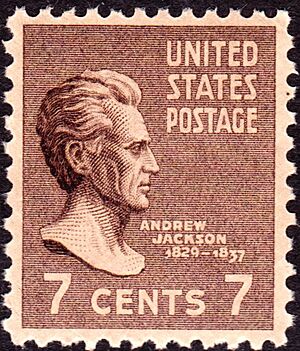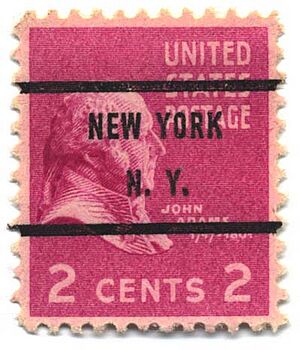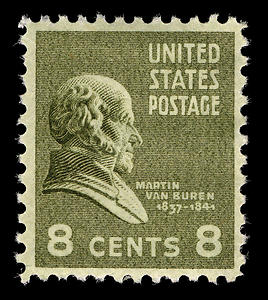Presidential Issue facts for kids
The Presidential Issue is a special series of postage stamps released in the United States in 1938. Stamp collectors often call them the Prexies. This collection features all 29 U.S. presidents who served between 1789 and 1928. These presidents range from George Washington to Calvin Coolidge.
The stamps show small pictures of the presidents' heads. For stamps up to 50 cents, the pictures are solid colors. For $1, $2, and $5 stamps, the pictures are black and white with colorful designs around them. The series also includes stamps with Benjamin Franklin and Martha Washington. There's even one with a picture of the White House. With 32 stamps in total, this was the largest set of regular stamps the U.S. Post Office had ever made.
In 1933, President Franklin D. Roosevelt had the idea for these stamps. He was a serious stamp collector himself! In 1937, a national contest was held. The goal was to find a designer for the first stamp, the 1-cent George Washington stamp. Over 1,100 people sent in their ideas. A New York artist named Elaine Rawlinson won the contest. Her design for the 1-cent stamp showed Washington's profile. It was based on a sculpture by Jean-Antoine Houdon. This design became the model for all the new stamps released in 1938.
Contents
Designing the Presidential Stamps
The pictures for the stamps were created from different sources. These included paintings, sculptures, and even bronze statues. All the images were made to look similar. They were printed using a special method called intaglio, which means the design is etched into a metal plate.
Each stamp has a solid colored background. On stamps up to 50 cents, the president's name is next to his picture. The years he was president are also listed below his name. For Benjamin Franklin and Martha Washington, no dates are shown. Stamps from 10 cents to 19 cents have a single line border. Stamps from 20 cents to 50 cents have a double line border. The $1, $2, and $5 stamps have a different design. They show colored columns and stars next to the president's black-and-white picture. The president's name and years in office are below his image.
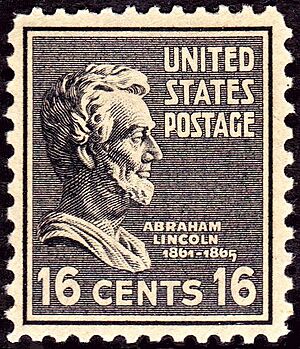
Portrait taken from bust of Lincoln by sculptor Sarah Fisher Ames
|
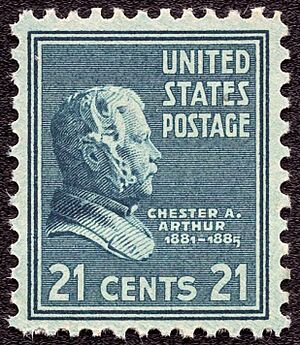
from a marble bust by Augustus Saint-Gaudens
|
The Design Contest for Stamps
On June 22, 1937, the Treasury Department announced a contest. They wanted new designs for a regular series of postage stamps. People had until September 15, 1937, to send in their ideas. The top three winners would receive cash prizes. A group of stamp experts and art experts judged the entries.
More than 1,100 designs were submitted. Many were eliminated, and the rest were scored. Elaine Rawlinson from New York City won first prize. Charles Bauer from West Orange, New Jersey came in second. Edwin Hoyt Austin from Delmar, New York, was third. Interestingly, no single judge voted for Rawlinson's design as their first choice.
Some artists sent in several designs. This included J.S. Stevenson from the American Banknote Company. Thomas F. Morris, Jr., whose father was a chief at the Bureau of Engraving and Printing, also submitted four designs.
About the Issued Stamps
The stamps that were released followed Elaine Rawlinson's winning design. There were some small changes to the borders on higher value stamps. But overall, the stamps looked very uniform.
Stamps from 1⁄2 cent up to 50 cents were printed in large sheets. They were made on a special machine called a rotary press. These stamps had perforations (small holes for tearing) that were 11 by 101⁄2 on the sides. The $1, $2, and $5 stamps had two colors. They needed a different printing method called flat-plate printing. Their perforations were 11 on all sides.
The series also cleverly showed the presidents in order. The first 22 presidents appeared on the single-cent stamps in the order they served. For example, George Washington, the first president, was on the 1¢ stamp. James Knox Polk, the eleventh president, was on the 11¢ stamp. Grover Cleveland, the twenty-second president, was on the 22¢ stamp.
Cleveland served two times, but not one after the other. He was both the 22nd and 24th president. This made the order a bit tricky. The 23rd president, Benjamin Harrison, was placed on the 24¢ stamp. Then, the 25th president, William McKinley, was on the 25¢ stamp. After that, the higher value stamps did not follow the exact numerical order of presidents.
Out of the 29 presidents in the series, 12 had never been on a U.S. postage stamp before. The Prexies also introduced four new stamp values: 18¢, 19¢, 21¢, and 22¢. Some of these values were included just to keep the presidents in order. They didn't match any common postal rates at the time.
As mentioned, Benjamin Franklin, Martha Washington, and the White House were on the 1⁄2¢, 1+1⁄2¢, and 4+1⁄2¢ stamps. Interestingly, it wasn't originally planned to match presidents with their numerical positions. For example, James Monroe was first announced as the subject for the 4+1⁄2¢ stamp.
The Prexies series changed some traditions. It was the first time since 1870 that George Washington was not on the regular letter rate stamp. In 1938, the 3¢ stamp was for letters, and Thomas Jefferson was on it. Washington was on the 1¢ stamp, which was for postcards. This was also a change, as Franklin usually appeared on the postcard stamp. However, Franklin did start the series on the 1⁄2¢ stamp. This informally honored him as the "halfth" president.
Many people felt that the Prexies series fit the "New Deal" ideas of the time. It was seen as a fun way to learn history. It also treated all presidents equally, no matter their achievements.
Coil and Booklet Stamps
On January 20, 1939, nine values of the stamps were released in coil form. These included all low values from 1¢ to 6¢, and the 10¢ stamp. They had vertical perforations. A week later, on January 27, the 1¢, 2¢, and 3¢ stamps were also issued in vertical coil form, but with horizontal perforations. On the same day, small booklets with the 1¢, 2¢, and 3¢ stamps went on sale. These had perforations that were 11 by 101⁄2.
A Special Watermark
In 1950 or 1951, the $1 Wilson stamp was reprinted. By mistake, the technicians used the wrong paper. They used paper meant for revenue stamps, which had a special watermark. This watermark showed the letters "U S I R." If you put one of these stamps in a special liquid, you can see these letters. These watermarked $1 stamps are not super rare, but they are worth about 30 times more than regular ones.
The Presidential Issue stamps were used for a long time. It was 16 years later, in 1954, that the postal service started replacing them. They were slowly replaced by stamps from the Liberty series over the next few years.
Collecting Prexies Stamps
One fun challenge for Prexie collectors is to find a cover (an envelope with stamps) that has just one Prexie stamp. For example, finding a cover with only a 16¢ stamp that paid a correct postage rate from that time is exciting. Many such covers are still being found. Sometimes, sellers on eBay are surprised when a normal-looking cover gets bids for hundreds of dollars. This happens when it's one of these rare "solo usages" that collectors are looking for.
Issue Dates and Catalog Numbers
Here are the dates each stamp was issued and its number in the Scott stamp catalog:
- Scott 803 - The 1⁄2¢ Benjamin Franklin - May 19
- Scott 804 - The 1¢ George Washington - April 25
- Scott 805 - The 1+1⁄2¢ Martha Washington - May 5
- Scott 806 - The 2¢ John Adams - June 3 (first time on a U.S. stamp)
- Scott 807 - The 3¢ Thomas Jefferson - June 16
- Scott 808 - The 4¢ James Madison - July 1
- Scott 809 - The 4+1⁄2¢ White House - July 11
- Scott 810 - The 5¢ James Monroe - July 21
- Scott 811 - The 6¢ John Quincy Adams - July 28 (first time on a U.S. stamp)
- Scott 812 - The 7¢ Andrew Jackson - August 4
- Scott 813 - The 8¢ Martin Van Buren - August 11 (first time on a U.S. stamp)
- Scott 814 - The 9¢ William Henry Harrison - August 18 (first time on a U.S. stamp)
- Scott 815 - The 10¢ John Tyler - September 2 (first time on a U.S. stamp)
- Scott 816 - The 11¢ James K. Polk - September 8 (first time on a U.S. stamp)
- Scott 817 - The 12¢ Zachary Taylor - September 14
- Scott 818 - The 13¢ Millard Fillmore - September 22 (first time on a U.S. stamp)
- Scott 819 - The 14¢ Franklin Pierce - October 6 (first time on a U.S. stamp)
- Scott 820 - The 15¢ James Buchanan - October 13 (first time on a U.S. stamp)
- Scott 821 - The 16¢ Abraham Lincoln - October 20
- Scott 822 - The 17¢ Andrew Johnson - October 27 (first time on a U.S. stamp)
- Scott 823 - The 18¢ Ulysses S. Grant - November 3
- Scott 824 - The 19¢ Rutherford B. Hayes - November 10
- Scott 825 - The 20¢ James A. Garfield - November 10
- Scott 826 - The 21¢ Chester A. Arthur - November 22 (first time on a U.S. stamp)
- Scott 827 - The 22¢ Grover Cleveland - November 22
- Scott 828 - The 24¢ Benjamin Harrison - December 2
- Scott 829 - The 25¢ William McKinley - December 2
- Scott 830 - The 30¢ Theodore Roosevelt - December 8
- Scott 831 - The 50¢ William Howard Taft - December 8
- Scott 832 - The $1 Woodrow Wilson - August 29
- Scott 833 - The $2 Warren G. Harding - September 29
- Scott 834 - The $5 Calvin Coolidge - November 17 (first time on a U.S. stamp)


